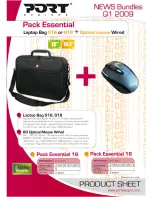
User’s Manual
Glossary-6
Glossary
dialog box:
A window that accepts user input to make system settings or
record other information.
disk drive:
The device that randomly accesses information on a disk and
copies it to the computer’s memory. It also writes data from memory
to the disk. To accomplish these tasks, the unit physically rotates the
disk at high speed past a read-write head.
disk storage:
Storing data on magnetic disk. Data is arranged on
concentric tracks much like a phonograph record.
display:
A CRT, LCD, or other image producing device used to view
computer output.
documentation:
The set of manuals and/or other instructions written for
the users of a computer system or application. Computer system
documentation typically includes procedural and tutorial information
as well as system functions.
DOS:
Disk Operating System.
See
operating system.
driver:
A software program, generally part of the operating system, that
controls a specific piece of hardware (frequently a peripheral device
such as a printer or mouse).
DVD-RAM:
A Digital Versatile Disc Random Access Memory is a high-
capacity, high performance disc that lets you store large volumes of
data. The DVD-ROM drive uses a laser to read data from the disc.
DVD-ROM:
A Digital Versatile Disc Read Only Memory is a high capacity,
high performance disc suitable for play back of video and other
high-density files. The DVD-ROM drive uses a laser to read data
from the disc.
E
echo:
To send back a reflection of the transmitted data to the sending
device. You can display the information on the screen, or output it to
the printer, or both. When a computer receives back data it
transmitted to a CRT (or other peripheral device) and then
retransmits the data to printer, the printer is said to echo the CRT.
erase:
See
delete.
escape:
1) A code (ASCII code 27), signaling the computer that what
follows are commands; used with peripheral devices such as
printers and modems.
2) A means of aborting the task currently in progress.
escape guard time:
A time before and after an escape code is sent to the
modem which distinguishes between escapes that are part of the
transmitted data, and escapes that are intended as a command to
the modem.
execute:
To interpret and execute an instruction.
Extended Capability Port:
An industry standard that provides a data
buffer, switchable forward and reverse data transmission, and run
length encoding (RLE) support.












































